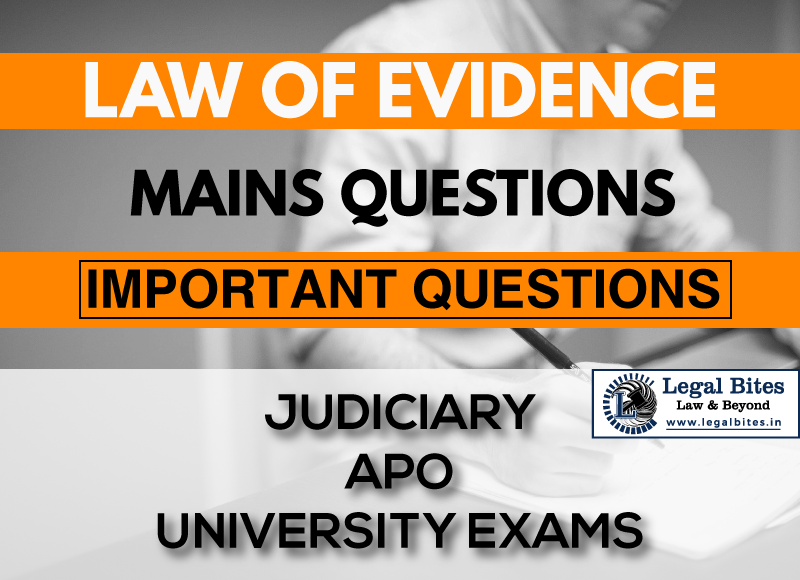What evidence is to be given when a statement forms part of the conversation, document, electronic record, book, or series of letters or papers?
Question: What evidence is to be given when a statement forms part of the conversation, document, electronic record, book, or series of letters or papers? Find the answer to the mains question only on Legal Bites. [What evidence is to be given when a statement forms part of the conversation, document, electronic record, book, or series of letters… Read More »

Question: What evidence is to be given when a statement forms part of the conversation, document, electronic record, book, or series of letters or papers? Find the answer to the mains question only on Legal Bites. [What evidence is to be given when a statement forms part of the conversation, document, electronic record, book, or series of letters or papers?] Answer Section 39 of the Indian Evidence Act talks about what evidence is to be given when a statement forms part of a...
Question: What evidence is to be given when a statement forms part of the conversation, document, electronic record, book, or series of letters or papers?
Find the answer to the mains question only on Legal Bites. [What evidence is to be given when a statement forms part of the conversation, document, electronic record, book, or series of letters or papers?]
Answer
Section 39 of the Indian Evidence Act talks about what evidence is to be given when a statement forms part of a conversation, document, electronic record, book or series of letters or papers:
When any statement of which evidence is given forms part of a longer statement, or of a conversation or of a conversation part of an isolated document, or is contained in a document which forms part of a book or is contained in part of an electronic record or of a connected series of letters or papers, evidence shall be given of so much and no more of the statement, conversation, document, electronic record, book or series of letters or papers as the Court considers necessary in that particular case to the full understanding of the nature and effect of the statement, and of the circumstances under which it was made.
The real meaning of a sentence or a passage can be understood by reading the whole of the literature of which the sentence or the passage forms a part. We must read the whole, not because we desire the remainder for its own sake, but because without that we cannot be sure that we have the true sense and effect of the first part,
“It is at all times a dangerous thing to admit a portion only of a conversation in evidence because one part taken by itself may bear a very different construction and have a very different tendency to what would be produced if the whole were proved; for one part of the conversation will frequently serve to qualify and to explain the other.”
The court has the discretion to use the relevant portion of the conversation, document, books or series of letters or papers and requires the production of that portion or pages. In other words, the evidence shall be given of only explanatory or qualifying part of the statement, document, book etc. The same is applicable to electronic records under the section. The statements made in books cannot be relied on unless supported by contemporaneous records.
For this reason, Section 39 lays down that when a statement, to be proved, is part of
- a longer statement, or
- a conversation, or
- an isolated document, or
- a document contained in a book, or
- a series of letters of papers, or papers
as the court considers in that particular case, necessary to the full understanding of the nature and effect of that statement and of the circumstances in which it was made.
But that part that is not helpful in understanding the meaning of the relevant statement shall not be proved.
What is rendered admissible under this section is that which the court finds necessary in order that the statement may be intelligible. But it cannot be said that because a document is admissible for a certain purpose all recitals, statements and references therein can be used as proof of the facts to which they relate as held in Tikaram v. Moti Lal, AIR 1930 All 299.
What evidence is to be given and to be taken is the total discretion of the judge. His discretion is always guided by principles of justice, conscience and convenience. But it must be remembered that evidence that has been debarred by some Section of Evidence Act cannot be brought on record under Section 39
Important Mains Questions Series for Judiciary, APO & University Exams
- Law of Evidence Mains Questions Series Part-I
- Law of Evidence Mains Questions Series Part-II
- Law of Evidence Mains Questions Series Part-III
- Law of Evidence Mains Questions Series Part-IV
- Law of Evidence Mains Questions Series Part-V
- Law of Evidence Mains Questions Series Part-VI
- Law of Evidence Mains Questions Series Part-VII
- Law of Evidence Mains Questions Series Part-VIII
- Law of Evidence Mains Questions Series Part-IX
- Law of Evidence Mains Questions Series Part-X
Admin Legal Bites
Legal Bites Study Materials correspond to what is taught in law schools and what is tested in competitive exams. It pledges to offer a competitive advantage, prepare for tests, and save a lot of money.
